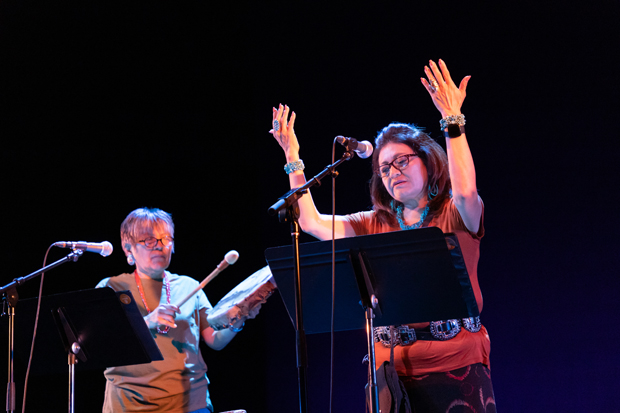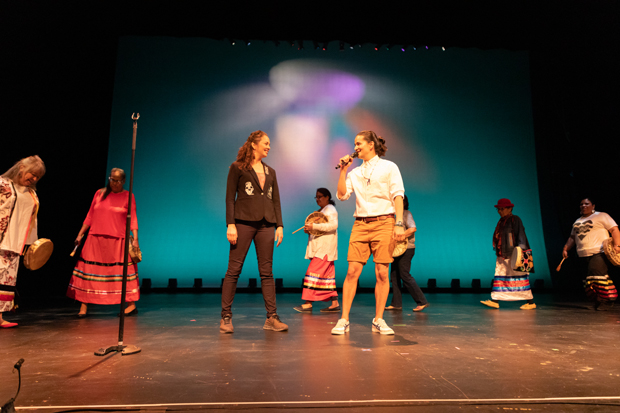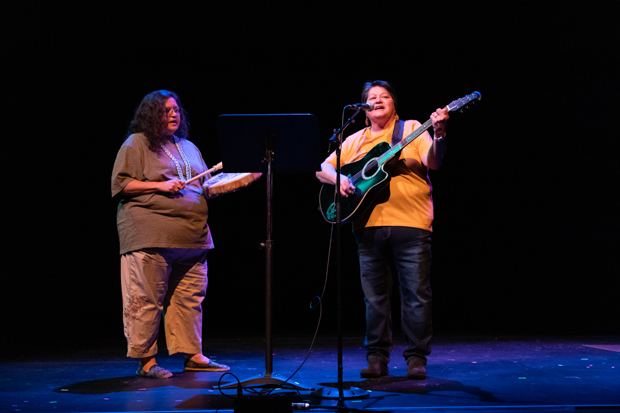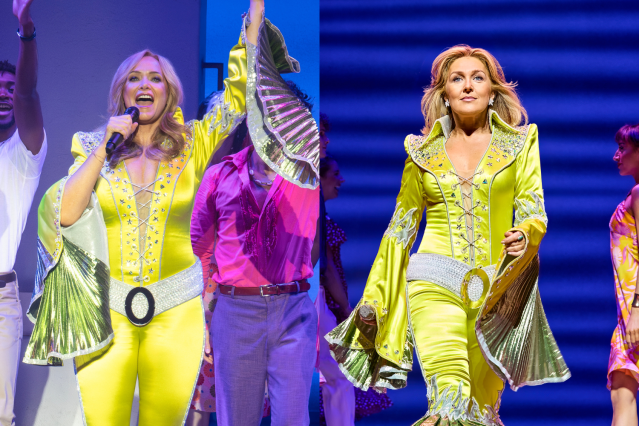
(© Jessica Kray Martin)
On a glittering Saturday evening, I took my seat at the Guthrie Theater’s McGuire Proscenium Stage to watch Stories From the Drum, a community-conceived and performed show. I knew that as of that morning there had not yet been a run-through of the show, that some last-minute content and cast changes had evolved as part of the process. The Guthrie team, accustomed to the rigors of professional theater tech and rehearsal schedules, was rolling with it.
The lights dimmed and for the next two hours, a drum choir, short plays, monologues, rap, and songs performed by Native artists and community members delighted the sold-out audience of 700. The audience itself was as diverse as Minneapolis these days: Native and non-Native, young and old, black, brown, and white. The seamless performances received a standing ovation. The challenges, triumphs, and the evolving voices of a community were heard onstage at Minnesota’s largest cultural organization for only the second time in its over-50-year history. The first had been two years before in a similar community-conceived piece, Water Is Sacred.
Theatre Forward, the organization I lead as Executive Director, was a major funder of this project through our Advancing Strong Theatre program, which launched in 2018. We are a nonprofit organization that supports a network of 19 prominent regional theaters across the country. Stories From the Drum exemplifies the national movement of community work now taking place.
Three other projects are also part of Advancing Strong Theatre. In Dallas and Seattle, we funded aspects of their Public Works programs, which are versions of the model created by New York’s Public Theater. In San Diego, the Old Globe’s Globe For All program’s new Latinx initiative was funded.
The Community Engagement Department at the Guthrie was created shortly after Artistic Director Joseph Haj arrived in 2015. “We serve our 400,000 audience members very well,” Joseph said. “But it’s not enough. And since the Twin Cities’ Indigenous community had never been meaningfully engaged by the Guthrie, it was a no-brainer that we should connect with them.”

(© Jessica Kray Martin)
The Guthrie reached out to Ty Defoe (Haudenosaunee, Six Nations/Anishinaabe Nation) and Larissa FastHorse (Sicangu Lakota), well-known Native American theater artists who operate a consulting company, Indigenous Direction, to help organizations and communities connect around the theatrical process. They also led Water Is Sacred.
Stories From the Drum had three program threads: a community-based creative process culminating in four performances in the 700-seat McGuire Proscenium Stage; transportation, meals, and tickets to Guthrie plays during the season; and Guthrie staff de-colonization training.
Jaida Grey Eagle, an Oglala Lakota born in Pine Ridge, South Dakota, and raised in Minneapolis, along with Marisa Carr, helped with community workshops and the audience visits to Guthrie shows. For most of the 120 people who came to the Guthrie during this past winter, this was their first time.
Larissa elaborated, “Many participants had always wanted to go to the Guthrie, but they were afraid because they didn’t know the culture and the rules. Coming as a group changed their perception of being in a theater. Others are deeply involved in Indigenous theater and they see the Guthrie as the flagship of middle America. So for them to be involved on that stage was deeply meaningful. It meant Western theater is giving Indigenous theater the legitimacy that it never receives.”
“We created a sense of community within the community,” Ty said. “It was very powerful for the Indigenous artists to be together and celebrate joy.”
Jaida was also very involved in another key feature of the program, the pop-up market for local Indigenous makers. “Our art is our survival, our culture, and for a long time it was not widely valued. That is changing. The Guthrie gift store is going to start carrying Indigenous art.”
Rebecca Noon, Director of Community Engagement, drilled down further on the ideas Joseph Haj spelled out. “By not engaging the Indigenous community,” she said, “the Guthrie is missing an honesty about the land we are on, the shores of the Mississippi, which is sacred to many tribes. We are missing the impact of cultures that were here before us and are still here. And for the staff, this program is a real point of pride because we are working to create a space of understanding and not dictate how it will be used.”
Joseph Haj has also made this point. Standard theater practices requiring months of preparation and standardization were set aside for both editions of this project. “It gives our staff a chance to push the edges of how we do things.”
The de-colonized working process of Stories From the Drum offers new models for theater creation. Larissa and Ty emphasized transparency and a non-hierarchical approach. “We created ritualized intentionality whenever we met as a group,” Ty explained. “We got into a circle with the Guthrie staff when we did our workshop, and before every show. Every person could steward a beloved community to tell these Indigenous stories.”

(© Jessica Kray Martin)
“You’re opening the doors to both the past and the future,” Larissa said. “You’re finding ways forward to reconcile the past. It’s not always easy work but a lot of community building and listening has to happen. The Guthrie is learning to be a better neighbor than they have been. It’s hard and it takes a while. We trust that the Guthrie is committing to that process long term.”
This expansion in the role of theater is a return to the dreams built into the regional theater model in the first place: to serve the community with theater for that community. The tools of theater: rehearsal, writing, acting, collaboration, design, public performance, are powerful tools of social connection and community building. For too long, these tools were applied to programming that intentionally or not, excluded large sections of our fellow citizens. Programs like Stories From the Drum bring to theater voices as old as the Greeks, now performed in their place of origin in fresh and inclusive ways.
Bruce E. Whitacre is Executive Director of Theatre Forward, a nonprofit organization that supports a network of 19 prominent regional theaters in their efforts to enrich communities and make theater accessible to all. Stories From the Drum is part of Theatre Forward’s Advancing Strong Theatre initiative, which is made possible by contributions from James and Lynne Turley, Stephanie Scott, the Schloss Family Foundation, Citi, Bank of America, Rusty and Patti Rueff, and the board of Theatre Forward. For more information, go to www.theatreforward.org.








